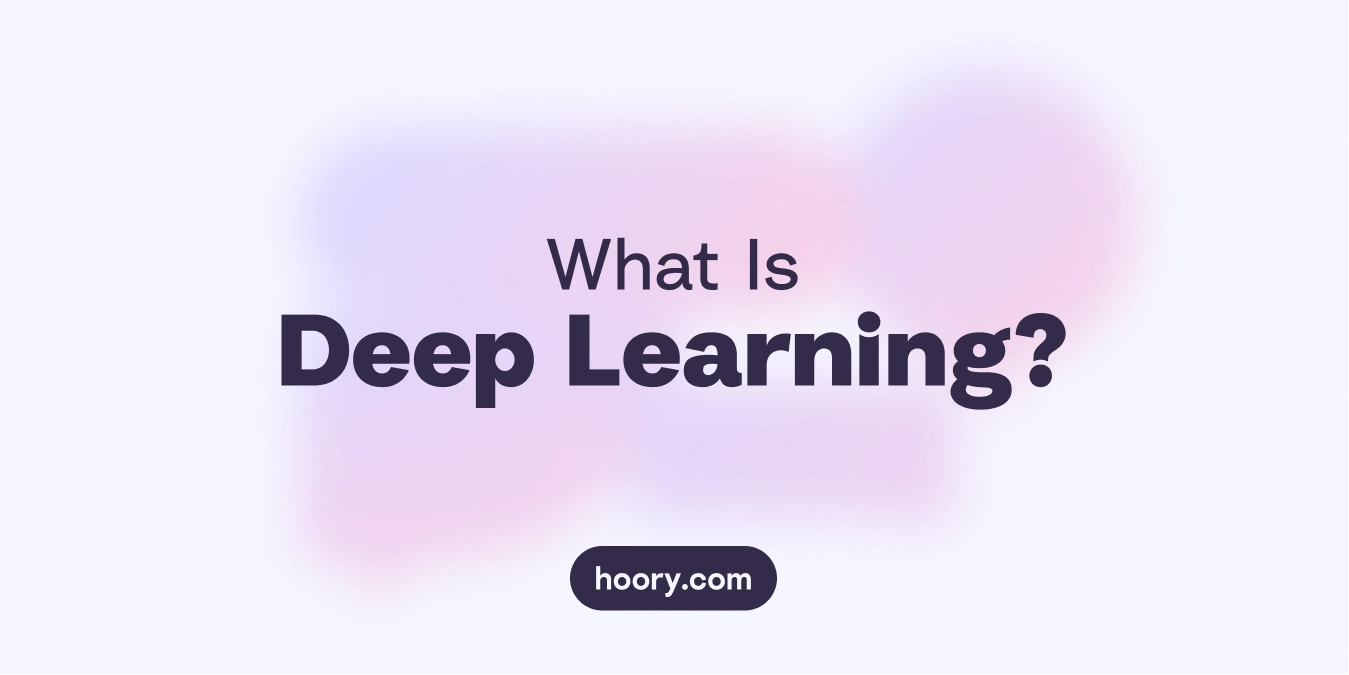What Is Deep Learning and How Does It Work? A Deep Dive
• Customer Support
• FastBank

The prevailing question posed by researchers, computer scientists, and all of us with a fascination for technology is: How close can machines get to the human brain? This daring inquiry led to the formation of an entire field of study dedicated to just that. Introducing you to deep learning, a subset of machine learning and artificial intelligence that teaches computers to learn as we do.
There’s a lot to discuss on deep learning, how it works, and all the tangible ways it’s influencing our lives. So if you’re ready to explore, let’s jump right in!
What Is Deep Learning?
We’ll begin with the deep learning definition.
Deep learning (DL) is a subset of machine learning and a subfield of artificial intelligence that aims to replicate how humans learn from unfamiliar data. It works based on a series of algorithms called artificial neural networks (ANNs) — computer systems modeled after the actual biological networks of the human brain. Similar to the neurons that make up our brains, ANNs consist of connected nodes, also known as artificial neurons. These fully connected neural networks enable complex computations and pattern recognition.
The fascinating resemblance between these artificial systems and those of our biological brains enables machines to stimulate the learning patterns of humans. The reason why it’s called “deep” learning is that it uses neural networks with three or more layers. The extra hidden layers help DL models achieve an astonishing level of accuracy, even outperforming humans at times.
DL models are implemented in various learning methods, such as supervised learning and unsupervised learning. While supervised learning relies on data sets labeled by humans to make predictions, unsupervised learning works with unlabeled data.
DL has certainly stretched the boundaries of what we thought possible. Today, it’s at the core of many AI technologies, such as virtual assistants, translation software, self-driving cars, smart home systems, and the like.
Deep Learning vs. Machine Learning vs. AI
While deep learning, machine learning, and artificial intelligence overlap, there are still vital distinctions to make to understand each of these areas better. So what is the difference between machine learning and deep learning?
A key point in the deep learning vs. machine learning comparison is the way of working with data. Machine learning (ML) algorithms work with organized, structured data sets where specific features in the data are already defined. In comparison, DL algorithms can process raw, unstructured data and automate feature extraction, eliminating the need for human supervision.
For instance, you can give DL models a large set of unlabeled random images that need to be classified. DL algorithms will process the images independently and determine a hierarchy of features according to which they will categorize those images. If the task is to group photos with a car, the computer will define distinctive characteristics to look for in the photos, such as wheels, side mirrors, bumpers, headlights, etc.
Machine learning is preferred when the available data is relatively small, there’s clear feature understanding, and the task at hand is not too complicated. DL tends to work better with massive data sets where it can detect complex hidden patterns and improve accuracy as the data size grows. DL processes are also more technically demanding and require a high-performance GPU.
Now, as to artificial intelligence (AI), things will become much clearer when we define the term. AI is the ability of machines to imitate human intelligence, and deep learning is one way to achieve it. The image below will help you visualize the hierarchy of AI, ML, and DL.
Deep Learning and Neural Networks
Deep learning is sometimes called “deep neural learning” or “deep neural networking,” as it has artificial neural networks at its core. Simply put, deep learning refers to neural networks with three or more layers.
Multi-layered neural networks pass the input data through each layer of connected nodes. They consist of an input layer and output layer (also called visible layers) and multiple hidden layers in between the two.
Below is an example of artificial neural network architecture:
Every node in a layer is tasked with a simple operation, after the completion of which it passes the results onto the next layer. As the layers progress, the tasks become more and more specific to generate an accurate output.
The more layers a model has, the more hidden patterns will be found. Deep learning algorithms are more effective in data classification because they have several (sometimes dozens and hundreds) hidden layers. But this also means they’re more resource-intensive and require large amounts of data to be trained on.
How Deep Learning Works
Imagine a child with no prior knowledge of or experience with animals trying to learn what a bird is. At first, the child will be confused as to why an eagle is considered a bird while a cat isn’t. The only way to clear out the confusion is to show them many different examples of birds.
With enough time and exposure, the kid will develop a system of recognizing the key features birds possess. The feathers, wings, beaks, typical body sizes, and environments where they’re often found will all stand out as distinguishing features.
DL algorithms follow the same principle. They use data inputs, weights, and biases to identify and classify objects in the given data and make predictions. The more data, hidden layers, and time they have, the more precise the predictions become.
In a process called backpropagation, the algorithms assess their predictions against the ground truth to identify any errors. They then return and adjust the weights and biases to minimize the loss function and refine the outcome. Another fundamental concept in DL is action potential propagation, which is analogous to how neurons transmit signals, ensuring information flows efficiently through artificial neural networks.
It’s also worth noting that deep learning algorithms can initially train on data labeled by humans. Using the information gained from the training data, machines extract recurring features to be able to make predictions. This is why the size of the training data plays a significant role in determining the accuracy of the predictive models.
What Are the Benefits of Deep Learning?
Below you’ll find some of the most important advantages we gain from deep learning.
Hidden Insights From Data
DL models trained on big data can reveal hidden properties, patterns, and relationships within data that might not even be apparent to humans. These models are instrumental in collecting insights for research, business, marketing purposes, and not only. A huge advantage is that these models can work with various information sources like images, videos, text, etc.
Reduced Human Factor
DL minimizes the need for human action since its algorithms conduct feature extraction on their own. This makes the process much faster and reduces the risk of human error. DL-powered programs have even exceeded human performance on many occasions, one of the most notable ones being when a computer beat world-class players in a poker tournament.
Unparalleled Efficiency
With enough computing capacity, DL algorithms can perform hundreds, if not thousands, of tasks in a matter of minutes. They can also be trained and retrained over and over, increasing performance efficiency each time. Of course, their speed of completing tasks involving big data is incomparable to that of humans.
Where Is Deep Learning Applied?
From stock market trading to cybersecurity and medical diagnosis, deep learning has influenced many industries we interact with every day. Here are some examples of its modern applications.
AI Assistants
The most common use of deep learning in daily life comes with AI-powered assistants. It is used in natural language processing and speech recognition, so the AI assistants that implement those rely on DL. Voice-activated home devices, for instance, use deep learning to recognize the owner’s voice and learn their preferences. Similar technology is used for business assistants to gather and analyze customer data.
Automated Driving
Self-driving cars use DL models to detect routes, recognize road signs and pedestrians, and even park. Through deep reinforcement learning, which uses multiple hidden layers of artificial neural networks to accomplish tasks with the trial-and-error process of reinforcement learning, algorithms assess their decisions using rewards and penalties to optimize their further actions. Below is an example of how AI learns to park in a 3D simulation.
Text Generation
Systems powered by deep learning can learn grammar and semantics to generate text. This is used in social media to paraphrase sentences, create automatic video captions, etc. It also plays a big role in machine translation, whether it's through written text or speech. The Deep translator is a remarkable example of how such programs can achieve a high level of accuracy when dealing with text.
Object and Face Recognition
Computer vision continues to make strides in object detection and face recognition using deep learning. It’s how your phone can recognize and memorize your face from photos, how Instagram can apply filters in real-time, how objects can be found in social media images, and so on. These possibilities are incredibly valuable not only for entertainment but also for security purposes.
Robotics
Robots that accompany and help us with different day-to-day tasks are no longer a sci-fi dream but a reality thanks to deep learning. While Sophia, the most popular humanoid robot, might not have perfectly mastered facial expressions, she’s still a marvelous embodiment of the big promises of robotics. Today, robots are used as assistants in manufacturing, healthcare, logistics, and many other fields.
Summing Up
Data scientists are still in the process of uncovering the immense possibilities deep learning has presented us with. This promising subfield of machine learning has surprised many with its potential to solve issues faster and achieve impressive levels of accuracy.
In the era of big data, the importance of deep learning continues to rise, urging more industries to adopt it. AI assistants, self-driving cars, and automatic text generators are only a few examples of how much there is to be gained from these remarkable advancements.

























